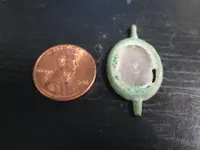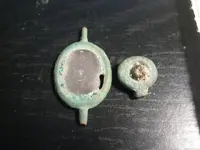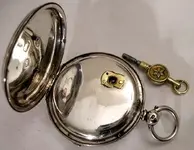You are using an out of date browser. It may not display this or other websites correctly.
You should upgrade or use an alternative browser.
You should upgrade or use an alternative browser.
✅ SOLVED Watch winder?
- Thread starter Garabaldi
- Start date
TheCannonballGuy
Gold Member
- Joined
- Feb 24, 2006
- Messages
- 6,606
- Reaction score
- 13,450
- Golden Thread
- 0
- Location
- Occupied CSA (Richmond VA)
- Detector(s) used
- White's 6000, Nautilus DMC-1, Minelab
- Primary Interest:
- Relic Hunting
The small brass object you found does have the characteristics of a pocketwatch winding key (with the "business" part of it broken off). It is most probably from sometime in the early or middle 1800s, because keywound pocketwatches were superceded by the stemwinding type in the latter 1800s.
Upvote
0
TheCannonballGuy
Gold Member
- Joined
- Feb 24, 2006
- Messages
- 6,606
- Reaction score
- 13,450
- Golden Thread
- 0
- Location
- Occupied CSA (Richmond VA)
- Detector(s) used
- White's 6000, Nautilus DMC-1, Minelab
- Primary Interest:
- Relic Hunting
It's possible that the second part is broken off from the main body of the winding-key ...but I can't be certain about that. Here's a photo showing an example of the type of key you you found. There are MANY variations of pocketwatch winding-keys.
The reason I'm uncertain that the two pieces you found were originally a single object is that the "stub" on the second piece is wider than either of the stubs on the first piece. Seems like the stub-width should be the same, if one was broken off from another.
The reason I'm uncertain that the two pieces you found were originally a single object is that the "stub" on the second piece is wider than either of the stubs on the first piece. Seems like the stub-width should be the same, if one was broken off from another.
Attachments
Upvote
0
BuckleBoy
Platinum Member
- Joined
- Jun 12, 2006
- Messages
- 18,132
- Reaction score
- 9,701
- Golden Thread
- 4
- Location
- Moonlight and Magnolias
- 🥇 Banner finds
- 4
- 🏆 Honorable Mentions:
- 2
- Detector(s) used
- Fisher F75, Whites DualField PI, Fisher 1266-X and Tesoro Silver uMax
- Primary Interest:
- All Treasure Hunting
Just a small point of edification here. In almost all cases, the stub, or "business end" of these watch winders were made of iron. Compared to brass, iron held up without being warped or reamed out in the process of winding the watch day after day for years. These small, thin iron pieces were affected by the elements and ground action, and so seldom survive. You may see a little rust spot on the brass at the end of the larger of the two nubs.
Best Wishes,
Buckles
Best Wishes,
Buckles
Upvote
0
Similar threads
- Replies
- 0
- Views
- 262
- Replies
- 7
- Views
- 759
Users who are viewing this thread
Total: 1 (members: 0, guests: 1)






